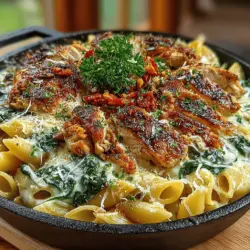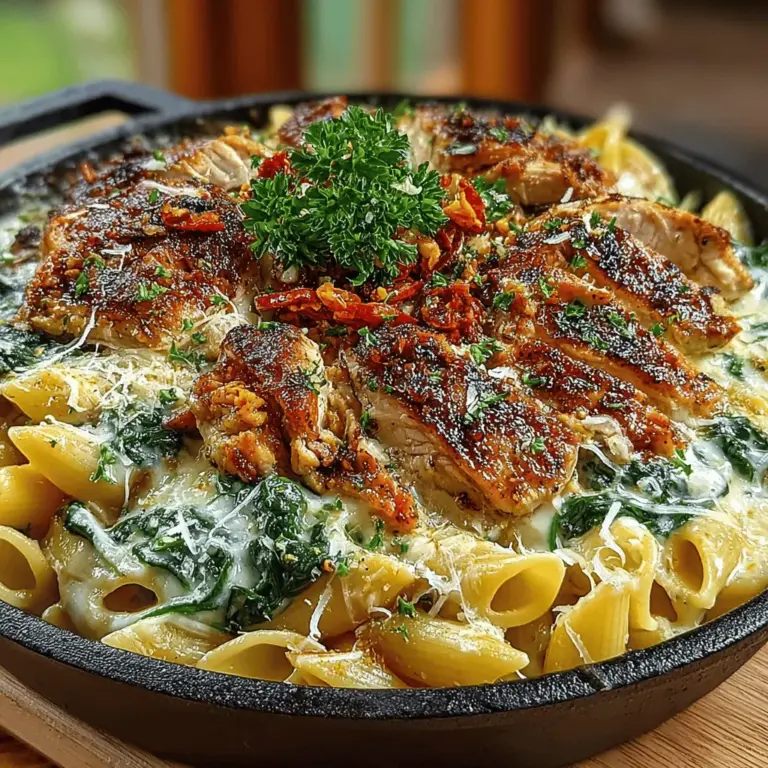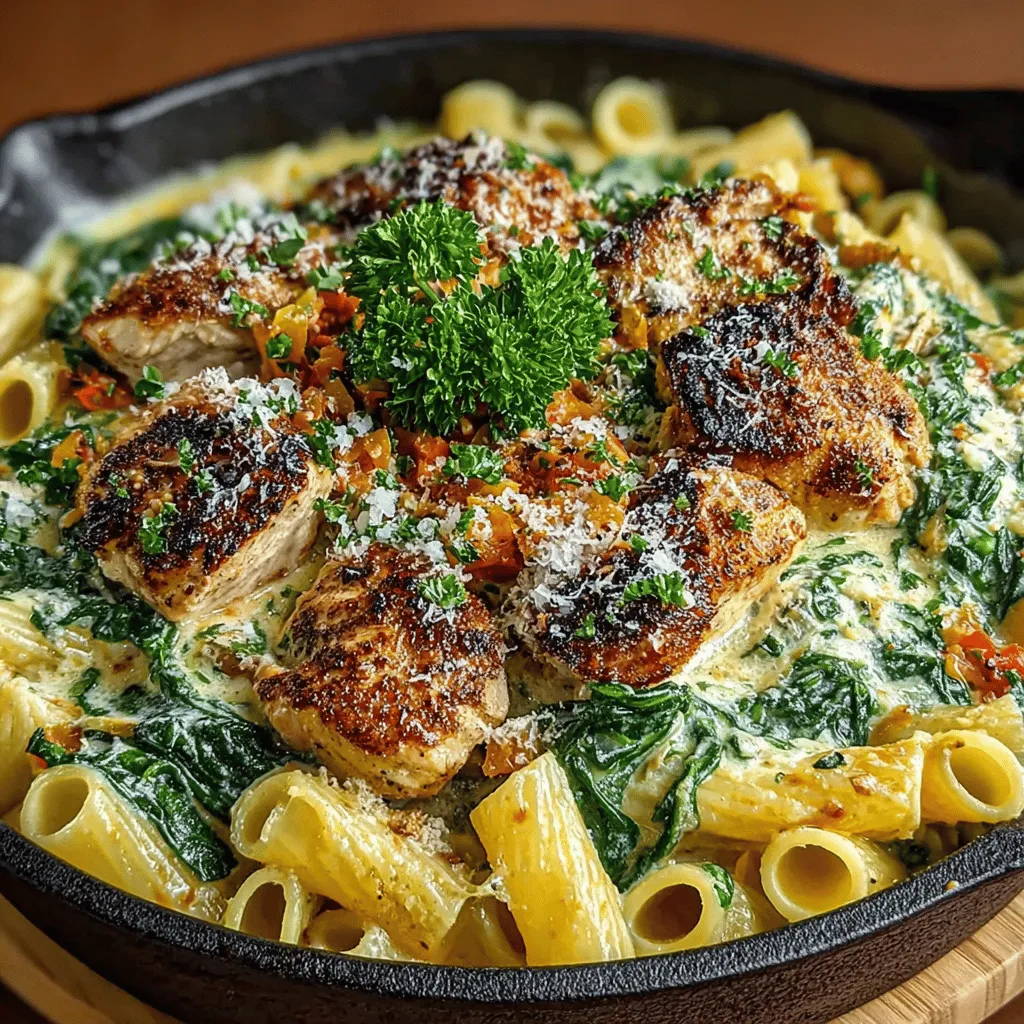Creamy Chicken and Spinach Skillet Pasta: A Culinary Delight for Every Occasion
In the ever-evolving world of home cooking, finding a dish that combines convenience, flavor, and nutrition can feel like searching for a needle in a haystack. Enter the Creamy Chicken and Spinach Skillet Pasta: a dish that checks all the boxes. Perfect for a busy weeknight dinner or a cozy weekend meal, this recipe brings together tender chicken, fresh spinach, and a luxuriously creamy sauce, all served atop al dente penne pasta. With its rich flavors and wholesome ingredients, it’s no wonder this dish has become a staple in many households.
The origins of a creamy pasta dish can be traced back to Italian cuisine, where pasta is often combined with rich sauces to create satisfying and hearty meals. However, the Creamy Chicken and Spinach Skillet Pasta takes this tradition a step further by incorporating lean protein and vibrant greens, making it not just a comfort food, but a balanced one as well. This dish showcases how easy it can be to prepare a restaurant-quality meal at home, all in a single skillet.
In this article, we will dive deep into the preparation of this delightful dish, exploring the ingredients, step-by-step instructions, variations, and the nutritional benefits of each component. Whether you’re an experienced cook or just starting out, this guide will help you master the art of making Creamy Chicken and Spinach Skillet Pasta.
Understanding the Ingredients
Penne Pasta: The Perfect Shape for Sauce and Ingredients
Penne pasta is an excellent choice for this recipe due to its tubular shape, which allows it to hold onto the creamy sauce and mix well with the other ingredients. The ridges on the pasta also add texture and help capture bits of chicken and spinach, ensuring every bite is bursting with flavor. When cooking penne, it’s essential to choose a high-quality brand to achieve the best texture and taste.
Boneless, Skinless Chicken Breasts: A Lean Protein Choice
Chicken breasts are the star of this dish, providing a lean source of protein that complements the creamy sauce. They cook quickly and can easily absorb the flavors of the seasoning and sauce. Opting for boneless and skinless chicken breasts not only makes preparation easier but also keeps the dish light and healthy. For added flavor, consider marinating the chicken or seasoning it generously before cooking.
Olive Oil: Why Quality Matters
Quality extra virgin olive oil is crucial in this recipe, as it serves as the foundation for sautéing the chicken and vegetables. Olive oil is rich in healthy fats and antioxidants, making it a nutritious choice for cooking. When selecting olive oil, look for a reputable brand and consider the flavor profile—some oils have a robust, peppery taste, while others are milder. This oil will enhance the overall flavor of the dish and provide a delicious base for the creamy sauce.
Garlic: The Flavor Enhancer
Garlic is a fundamental ingredient that elevates the flavor profile of any dish. In this recipe, minced garlic is sautéed with the chicken to create a fragrant base that infuses the entire dish with warmth and depth. Fresh garlic is recommended over pre-minced varieties, as it offers a more potent and aromatic flavor that complements the creaminess of the sauce beautifully.
Fresh Spinach: Nutritional Powerhouse
Spinach is not only a vibrant addition to this dish but also a nutritional powerhouse. Packed with vitamins A, C, and K, as well as iron and calcium, fresh spinach contributes a wealth of health benefits. Its delicate texture wilts perfectly when sautéed, adding a subtle earthy flavor and bright green color to the pasta. Opt for organic spinach when possible for the best taste and nutritional value.
Heavy Cream: The Key to Creaminess
Heavy cream is the secret ingredient that gives this dish its signature creaminess. It transforms the sautéed garlic and chicken into a velvety sauce that clings to the pasta. While heavy cream adds richness, it’s essential to use it in moderation to keep the dish balanced. If you prefer a lighter option, you can substitute half-and-half or even a plant-based cream.
Parmesan Cheese: Adding Depth of Flavor
Freshly grated Parmesan cheese is a must-have ingredient in this recipe. Not only does it enhance the creaminess of the sauce, but it also adds a savory, umami flavor that elevates the dish to a new level. When grating Parmesan, use a microplane for a fine texture that melts smoothly into the sauce. For those who are lactose intolerant, consider using a dairy-free cheese alternative to maintain the dish’s creamy element.
Italian Seasoning: A Blend of Aromatic Herbs
Italian seasoning is a blend of herbs that typically includes basil, oregano, thyme, and rosemary. This combination of flavors captures the essence of Italian cooking and adds an aromatic quality to the dish. While you can use store-bought Italian seasoning, making your own blend allows for customization based on personal preferences. Fresh herbs can also be used for an even brighter flavor profile.
Salt and Pepper: Essential Seasoning
Salt and pepper are fundamental to bringing out the flavors of every ingredient in this dish. Proper seasoning is crucial to achieving a well-balanced meal. Start with a pinch of salt while cooking the chicken, and adjust to taste as you incorporate the other ingredients. Freshly cracked black pepper adds a subtle heat that enhances the overall flavor without overpowering the dish.
Optional Ingredients: Red Pepper Flakes and Fresh Parsley
For those who enjoy a bit of heat, adding red pepper flakes can give the dish a delightful kick. This optional ingredient can be adjusted to your preferred spice level. Additionally, a sprinkle of freshly chopped parsley not only adds a pop of color but also a fresh, herbal note that brightens the dish.
Step-by-Step Guide to Making Creamy Chicken and Spinach Skillet Pasta
Preparing for Success: Kitchen Tools and Equipment
Before diving into the cooking process, it’s essential to gather the necessary kitchen tools and equipment. Having everything ready will streamline your cooking experience and ensure a successful outcome.
– Essential Tools for Cooking and Preparation: A sharp chef’s knife for chopping ingredients, a cutting board, measuring cups and spoons, and a wooden spoon or spatula for stirring are all essential tools. A kitchen timer can also be useful for keeping track of cooking times.
– Recommended Cookware for Optimal Results: A large skillet or sauté pan is ideal for this recipe, allowing ample space for cooking the chicken and pasta. A pot for boiling the pasta is also necessary. Non-stick cookware can be beneficial for easy cleanup, especially when working with creamy sauces.
Cooking the Pasta: Achieving the Perfect Al Dente Texture
The first step in making Creamy Chicken and Spinach Skillet Pasta is to cook the penne pasta to perfection. Cooking it al dente ensures that it retains a slight bite, which is essential for a satisfying texture when combined with the creamy sauce.
– Importance of Salted Water in Pasta Cooking: Begin by bringing a large pot of water to a boil and adding a generous amount of salt. Salting the water is crucial, as it flavors the pasta during cooking. A good rule of thumb is to use about one tablespoon of salt for every gallon of water.
– How to Know When Pasta is Done: Follow the package instructions for cooking time, usually around 10-12 minutes for penne. To test for doneness, taste a piece; it should be cooked through but still firm to the bite. Once cooked, reserve a cup of pasta water for later use, then drain the pasta and set it aside.
Sautéing the Chicken: Tips for Perfectly Cooked Chicken
While the pasta cooks, you can prepare the chicken. Properly sautéing the chicken is key to achieving a deliciously golden exterior while keeping the inside juicy.
– Seasoning for Maximum Flavor: Pat the chicken breasts dry and season generously with salt, pepper, and Italian seasoning. This not only enhances the flavor but also helps to create a beautiful crust when sautéed.
– Techniques for Browning Chicken Without Overcooking: In a large skillet, heat the olive oil over medium-high heat. Once the oil is shimmering, add the seasoned chicken breasts. Avoid overcrowding the pan, as this can cause steaming rather than browning. Cook for about 6-7 minutes on each side until golden brown and cooked through. To check for doneness, use a meat thermometer; the internal temperature should reach 165°F. Once cooked, remove the chicken from the skillet and let it rest before slicing it into strips.
Creating the Sauce: Building Layers of Flavor
With the chicken cooked and the pasta ready, it’s time to build the creamy sauce that will tie all the flavors together beautifully.
– The Role of Garlic in Enhancing the Dish: In the same skillet used for the chicken, add a bit more olive oil if needed and lower the heat to medium. Add the minced garlic and sauté for about 30 seconds, or until fragrant. Be careful not to burn the garlic, as it can turn bitter and ruin the sauce.
This initial preparation sets the stage for a delicious, creamy chicken and spinach skillet pasta that is sure to impress. In the next part of our guide, we’ll delve into the remaining steps of the recipe, from folding in the spinach and cream to combining everything into a cohesive and irresistible dish.
Tips for Incorporating Cream Without Curdling
When making creamy sauces, one common issue is curdling, which can happen if cream is added too quickly or at too high a temperature. Here are some practical tips to ensure your cream remains smooth and luscious:
1. Temperature Control: Always allow your pan to cool slightly after cooking the chicken before adding cream. This step helps in preventing temperature shock, which can lead to curdling.
2. Gradual Addition: Gradually add cream to the pan instead of pouring it all in at once. Start by adding a small amount, stirring continuously, and then slowly incorporate the remaining cream.
3. Mix with Starch: Mixing the cream with a small amount of flour or cornstarch before adding it to the skillet can help stabilize the sauce and prevent curdling.
4. Low Heat: Keep the heat low once the cream has been added. High heat can cause the cream to separate, leading to a grainy texture.
Incorporating Spinach: Balancing Flavor and Texture
The Importance of Fresh vs. Frozen Spinach
When it comes to spinach, both fresh and frozen varieties have their merits. Fresh spinach offers a vibrant color and a crunchy texture, while frozen spinach is convenient and often just as nutritious. If using frozen spinach, ensure you thaw and drain it well to avoid excess moisture in your dish. For a more intense flavor, fresh spinach is preferred, as it wilts beautifully and adds a lovely brightness to the pasta.
Techniques for Wilting Spinach Properly
To properly wilt spinach without losing its bright color and nutrients:
1. Sauté Quickly: Add fresh spinach to the skillet after the cream has been incorporated. Toss it in the hot sauce for just 1-2 minutes, allowing it to wilt quickly without overcooking.
2. Cover the Skillet: If you’re using a large batch of spinach, covering the skillet for a minute can help steam the leaves, ensuring they wilt evenly.
3. Season Gradually: Season the spinach lightly with salt and pepper as it wilts. This enhances its natural flavor without overwhelming the dish.
Combining Ingredients: Achieving the Right Consistency
How to Adjust Sauce Thickness with Pasta Water
One of the secrets to a perfectly creamy sauce is the use of pasta water. Here’s how to use it effectively:
– Reserve Pasta Water: Before draining your pasta, reserve about a cup of pasta water. This starchy liquid can be a game-changer in achieving your desired sauce consistency.
– Gradual Addition: Once your sauce is combined, add pasta water a little at a time. Stir well after each addition until you reach your preferred thickness. The starch in the water helps to bind the sauce to the pasta.
Ensuring Even Distribution of Flavors
For a well-rounded dish, it’s essential to ensure that all ingredients are evenly combined:
– Toss Gently: Once the pasta is added to the sauce, toss everything together gently. This method ensures that each strand of pasta is coated with the creamy sauce.
– Taste and Adjust: Before serving, taste the dish and adjust the seasoning if necessary. A pinch of salt or a squeeze of lemon can elevate the flavors significantly.
Serving Suggestions: Presenting Your Dish Beautifully
Garnishing Techniques for Visual Appeal
Presentation can elevate your dining experience. Here are some garnishing tips:
– Fresh Herbs: Sprinkle freshly chopped parsley or basil on top for a burst of color and freshness.
– Grated Cheese: A sprinkle of freshly grated Parmesan or Pecorino Romano adds a savory finish and visual interest.
– Lemon Zest: A light zest of lemon over the top brightens the dish and provides a fragrant aroma.
Pairing with Sides and Beverages
Complement your creamy chicken and spinach skillet pasta with suitable sides and beverages:
– Sides: A simple arugula salad dressed with lemon vinaigrette pairs beautifully, balancing the richness of the pasta. Garlic bread or crusty baguette can be served on the side for those who love to soak up the sauce.
– Beverages: A crisp white wine like Pinot Grigio or a light rosé can enhance the flavors without overpowering the dish. For a non-alcoholic option, sparkling water with a slice of lemon or lime is refreshing.
Nutritional Benefits of Creamy Chicken and Spinach Skillet Pasta
Analyzing the Nutritional Value of Each Ingredient
This dish not only delights the palate but also offers numerous health benefits:
– Benefits of Chicken as a Lean Protein Source: Chicken breast is an excellent source of lean protein, essential for muscle maintenance and growth. It is low in fat and provides vital nutrients such as B vitamins and selenium.
– Spinach: A Superfood Packed with Nutrients: Spinach is a nutritional powerhouse. It is rich in vitamins A, C, and K, as well as minerals like iron and calcium. The antioxidants found in spinach help combat oxidative stress and inflammation.
– The Role of Dairy in a Balanced Diet: The cream and cheese in this dish provide calcium and vitamin D, crucial for bone health. Incorporating dairy in moderation can be part of a healthy diet, supporting overall wellness.
How to Make the Dish Healthier Without Sacrificing Flavor
To enjoy this dish while keeping it light, consider these modifications:
– Use Low-Fat Dairy: Opting for low-fat milk or Greek yogurt instead of heavy cream can reduce calories without sacrificing creaminess.
– Increase Vegetables: Add more vegetables such as bell peppers or zucchini to enhance the nutritional profile without significantly increasing calorie count.
– Whole Wheat Pasta: Substitute regular pasta with whole wheat or legume-based pasta for added fiber and nutrients.
Variations and Customizations
Exploring Flavor Variations
This recipe is versatile and can be easily customized to suit your taste preferences:
– Adding Different Vegetables: Incorporate bell peppers, mushrooms, or zucchini for added texture and flavor. Sauté them along with the chicken for an all-in-one skillet meal.
– Protein Alternatives: If chicken isn’t your preference, consider using shrimp, tofu, or turkey. Each option brings unique flavors and textures to the dish.
– Dairy-Free Options: For a dairy-free version, substitute cream with coconut milk or cashew cream and use nutritional yeast instead of cheese for a cheesy flavor.
Adjusting for Dietary Preferences
This recipe can also be adapted for various dietary needs:
– Gluten-Free Pasta Options: For a gluten-free meal, use gluten-free pasta made from rice, quinoa, or lentils. Ensure that all other ingredients, including sauces and stocks, are gluten-free.
– Vegetarian and Vegan Adaptations: To make this dish vegetarian, omit the chicken and replace it with hearty vegetables or legumes. For a vegan version, use plant-based cream and cheese alternatives.
Conclusion
Creamy Chicken and Spinach Skillet Pasta stands out as a versatile, flavorful, and nutritious dish that can be adapted to suit various tastes and dietary needs. By following the steps outlined in this article, you can create a comforting meal that not only delights the palate but also nourishes the body. Whether enjoyed on a busy weeknight or shared at a gathering, this recipe is sure to become a favorite in your culinary repertoire. Embracing the balance of flavors and textures, this dish exemplifies the essence of home cooking—simple, satisfying, and full of love.


